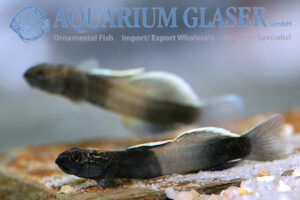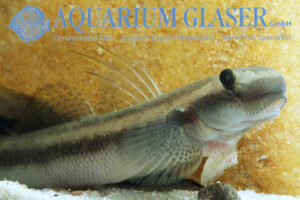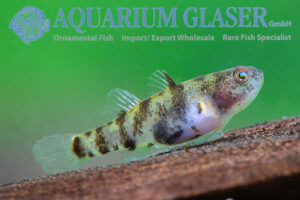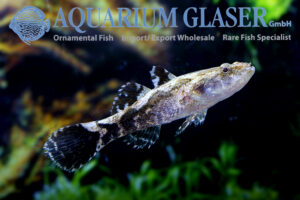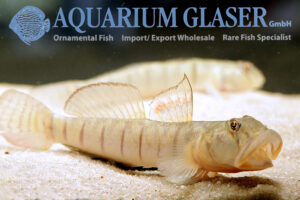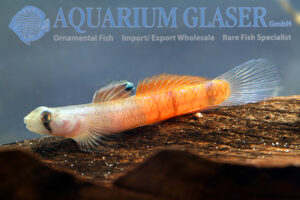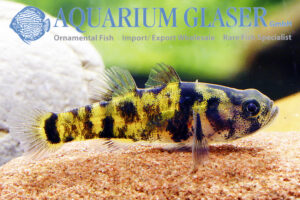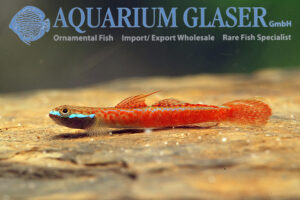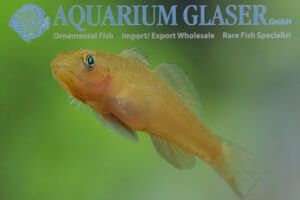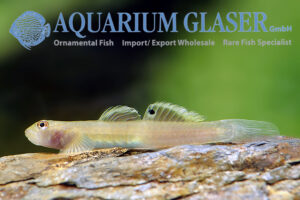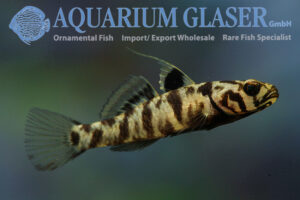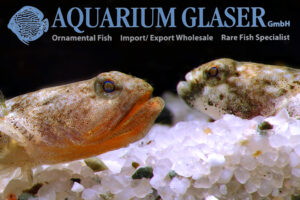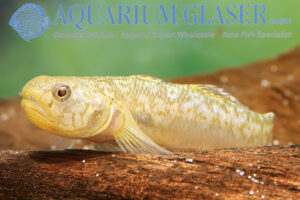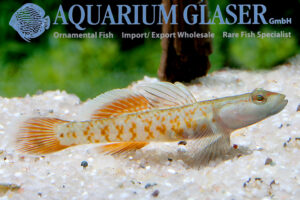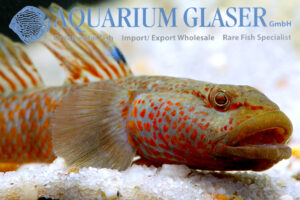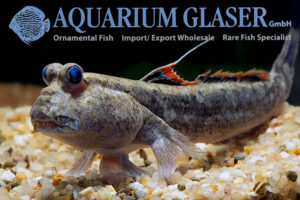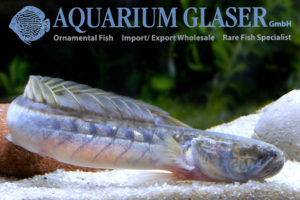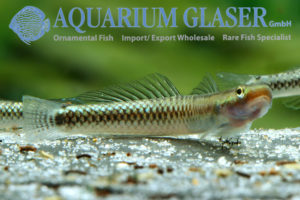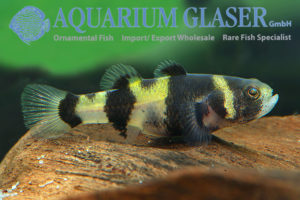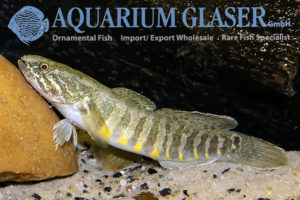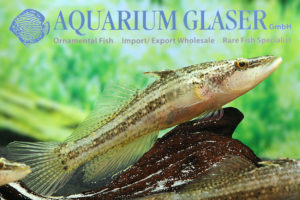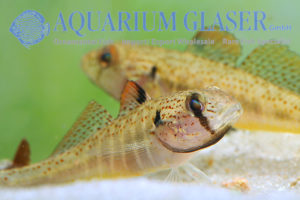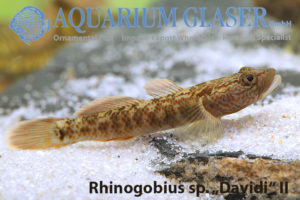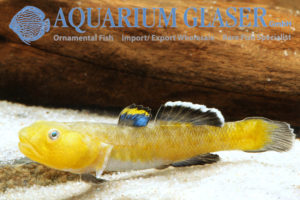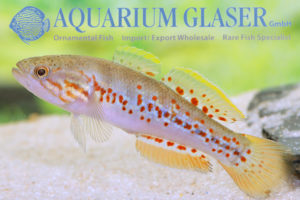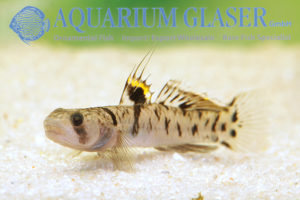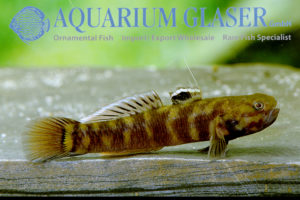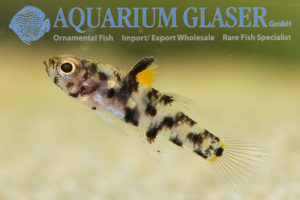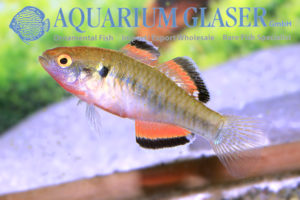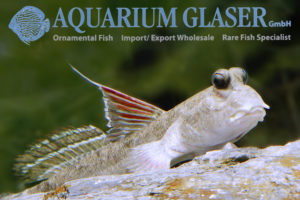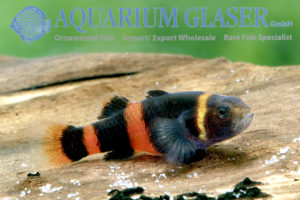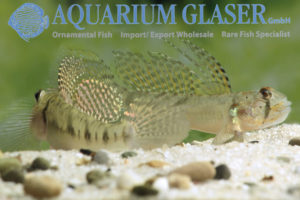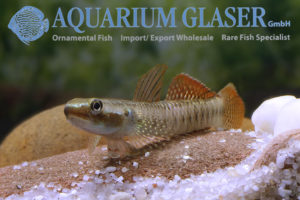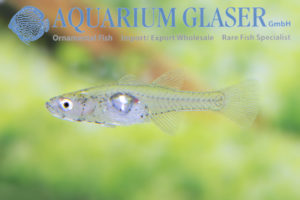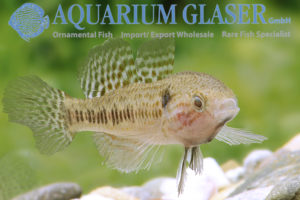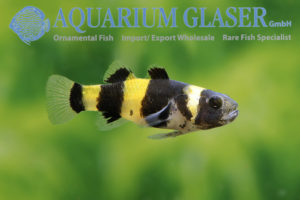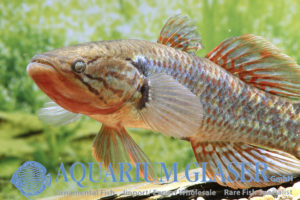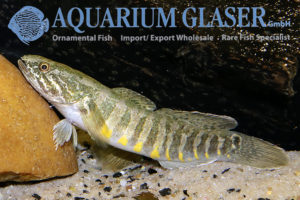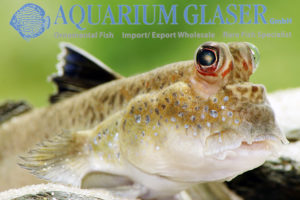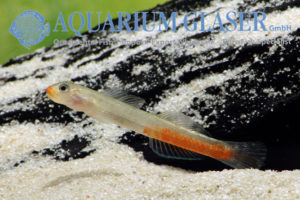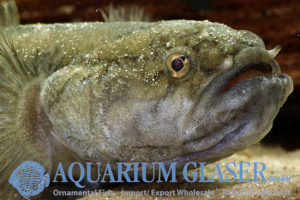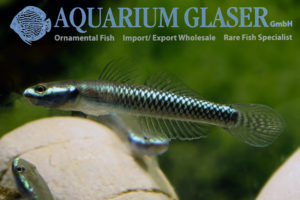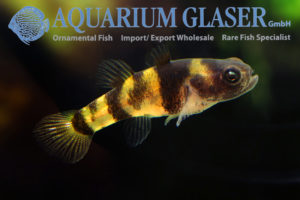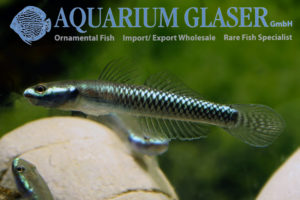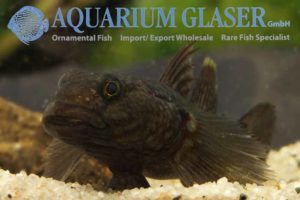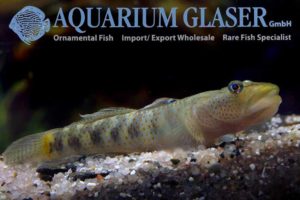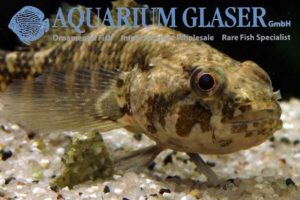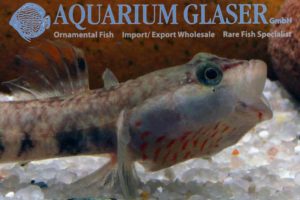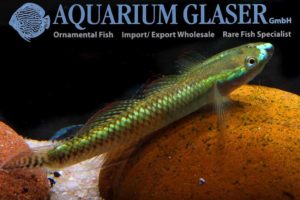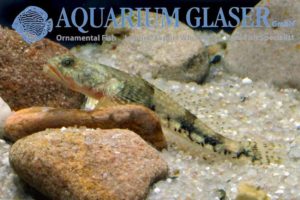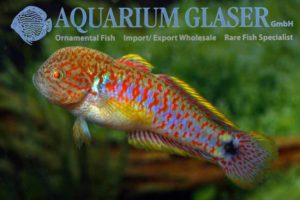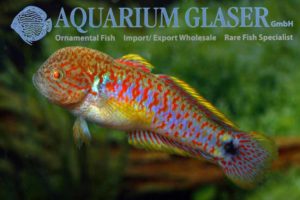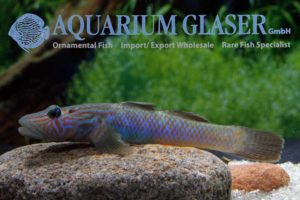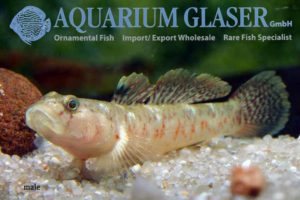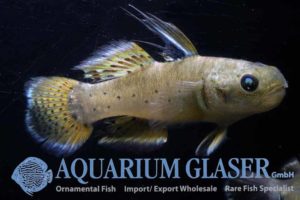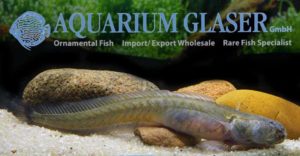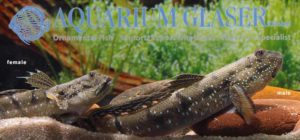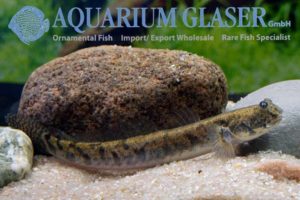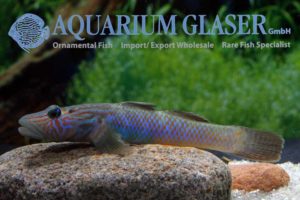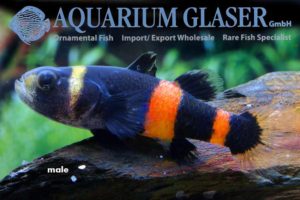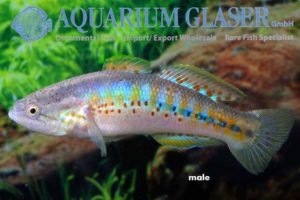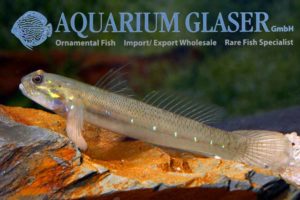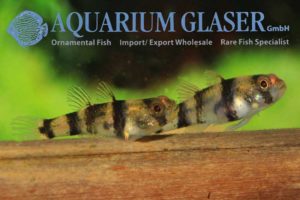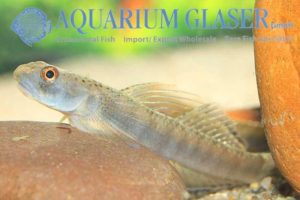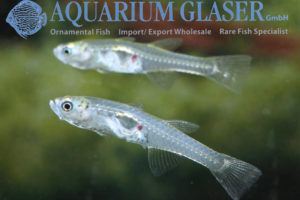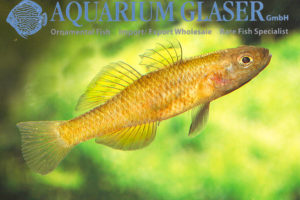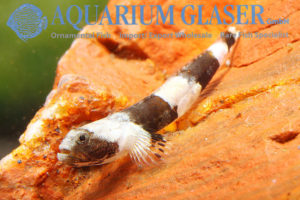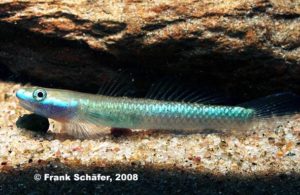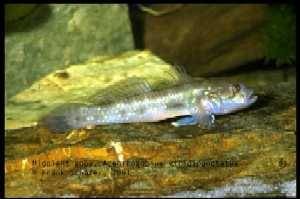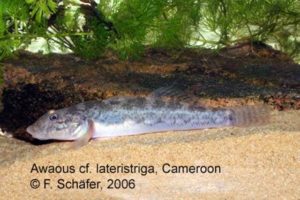This dwarf goby, a relative of the of neon gobies (Stiphodon), was scientifically described in 1999. To date, the species is only known from coastal rivers in western New Guinea (Irian Jaya). However, since it undergoes its juvenile development in the sea, like all sicydiine gobies, it is more than likely that it is much […]
25f. Perchlike fishes (6): Gobies (74)
-
-
Sicyopterus microcephalus (incorrectly imported as S. longifilis)
The genus Sicyopterus comprises the largest species of the increasingly popular sicydiine gobies, which include Stiphodon, Sicyopus, Sicydium, Lentipes, and others. All of these gobies undergo their larval development in the sea, while the adults live in pure freshwater and lay their eggs there. Since the larvae have hardly any yolk reserves, they must be […]
-
Brachygobius mekongensis
In the genus Brachygobius we find some of the smallest freshwater goby species. One of these dwarfs is B. mekongensis, a species that was only scientifically described in 2000. The late scientific recording of this species, which is widely distributed in the Mekong River basin in Laos, Cambodia and Thailand, is due to the fact […]
-
Oxyeleotris marmorata
Most gobies live in the sea. And most gobies stay small, usually less than 10 cm. So Oxyeleotris marmorata, the Marbled Sleepergoby, is an exception in more than only one respect. The species is a giant among the gobies and becomes more than 50 cm long. And usually it lives in pure freshwater; only occasionally […]
-
Awaous flavus ( = A. strigatus)
The butterfly goby (Awaous flavus, formerly known aquaristically under the synonym A. strigatus) has a large distribution area along the Atlantic coast of South America. They are found in the lower reaches of rivers in Brazil, Guyana, Suriname, Venezuela, Colombia and on islands off the coast. Adults of this species, which is a maximum of […]
-
Sicyopus zosterophorus
The gobies (Gobiidae) are probably one of the most species-rich families of fish with over 2,000 species (currently accepted: around 1,500 species). Many gobies live in the sea, but gobies are often the most common fish in the freshwater of oceanic islands. In these cases, they are usually species that live as adult fish in […]
-
Brachygobius sp. Ocelot
Again we could import this new species of dwarf bumble-bee goby. This tiny fish becomes only 2 cm long. It cannot be applied to any described species so far. The fish have been collected in Indonesia. In Brachygobius, one very important feature for determination is the question wether the predorsal region is scaled or naked. […]
-
Stiphodon annieae
Neon gobies of the genus Stiphodon are really wonderful aquarium fish. They have an interesting behavior, remain small, are not particularly demanding and the males are often beautifully colored. From an aquarium point of view, they have only one disadvantage: as the larvae develop exclusively in the sea, raising them presents the same difficulties as […]
-
Mugilogobius rexi
This small goby is a free swimming species, in contrast to most of the other gobies. Maximum length is about 4-5 cm. Territorial males become bright yellow and also develope larger fins with dark bands. Females are much paler in coloration and have translucent fins. The species is restrictet to Sulawesi and even on that […]
-
Lentipes ikeae
The goby subfamily Sicydiinae currently comprises nine genera with 121 species. They are all current-loving animals that occur in nature mainly in clear streams and feed on growth and small animals. Larval development takes place in the sea. Some neon gobies of the genus Stiphodon are particularly popular, representatives of other genera are rarely found […]
-
Mugilogobius adeia
This strikingly beautiful dwarf goby, which is endemic to Lake Matano on Sulawesi (formerly Celebes), was only scientifically described in 1992, although this lake has long been known as the focus of independent evolution and has been the subject of much research. The earliest findings probably date back to 1989, when Arthur Werner and Maurice […]
-
Schismatogobius risdawatiae
The dragonet gobies (Schismatogobius) are small species of freshwater gobies, that reach between 3 and 5 cm length. They live in small rivulets near the coast but above the tide on sandy bottoms. Here they burry themselves very fast if necessary. The larvae devolop – as far as this known – in the sea. The […]
-
Mugilogobius myxodermus
Small freshwater gobies have recently attracted the attention of more and more scientists and, as a result, new species are constantly being discovered and old, almost forgotten species rediscovered. The genus Mugilogobius currently comprises around 30 species. It is not possible to be more precise because individual species are placed in different genera by different […]
-
Rhinogobius zhoui
This freshwater goby, which attains a maximum length of 4-5 cm, is one of the most attractive discoveries of ornamental fish of the last years. However, in the beginning the fish were extremely expensive. Currently we can offer them for a comparably moderate price. Rhinogobius zhoui originates from China. In the natural habitat – brooks […]
-
Rhinogobius shennongensis (2)
The brook gobies (Rhinogobius) are as adult fishes pure freshwater inhabitants, which are found at most once in the brackish water of the lower reaches of running waters; but even this is the exception, not the rule. With 140 described species, 72 of which are generally considered valid, there is still a wide open field […]
-
Periophthalmodon septemradiatus
Within the true mudskippers – these are the species that actively leave the water and search for food on land, etc. – there are two genera: Periophthalmus (19 species) and Periophthalmodon (3 species). They do not differ externally, only in the structure of their teeth. We have now received Periophthalmodon septemradiatus from India, a beautiful […]
-
Gobioides broussonnetii
Only rarely we can offer the dragon fish, Gobioides broussonnetii, which actually is a species of goby. Now we received once again from Colombia this strange bottom dweller. The maximum length of the species is said to be about 40 cm. They are absolutely peaceful plankton eaters, which should be offered fine sandy substrate in […]
-
Stiphodon atropurpureus
The neon gobies of the genus Stiphodon are all beautiful fish. None of the 37 currently known species grows longer than 5-7 cm, usually they remain much smaller. Although adult Stiphodon live exclusively in pure freshwater, the larvae can only develop in the sea. Therefore, neon gobies live in streams near the coast. They spawn […]
-
Brachygobius sabanus Vietnam
From Vietnam we received this very nice bumble bee goby. The identification of bumble bee gobies is still in many cases a very tricky matter and often succeeds only with many question marks. Brachygobius sabanus was originally described from Borneo (Sabah), but our animals originate from Vietnam. However, the figure attached to the first description […]
-
Bostrychus zonatus
Bostrychus zonatus is a sleeper goby and becomes about 15 cm long. They are predatory fish, which should therefore only be kept together with species that have at least half the body length of the gobies, larger is safer. The beautiful animal is widespread in fresh and brackish water in New Guinea and northern Australia. […]
-
Butis gymnopomus
Sleeper gobies the genus Butis (there are 6 recognized species) belong to the most original members of their kind. They swim around in the aquarium in every imaginable posture, especially often with the belly up, but also upside down or with the snout up. Thereby they imitate a floating piece of wood and are not […]
-
Sineleotris saccharae
From the Hong Kong area comes this beautiful, but also delicate goby. The maximum length of the species is about 10 cm. The basic temperature requirements are well known from the White Clouds (Tanichthys albonubes), which occurs in the same region: 16-22°C for normal care, somewhat higher for breeding, short-term up to 28°C are tolerated. […]
-
Rhinogobius sp. “Davidi”
We have the great ambition to open up new species for aquaristics again and again. Therefore it is not excluded that we also import species whose scientifically exact determination is not successful, because simply not enough scientific research has been done about the animals so far. The extremely species-rich genus Rhinogobius is a good example […]
-
Chlamydogobius eremius
The desert goby (Chlamydogobius eremius) is a wonder of nature in terms of temperature adaptability. Originally it comes from the desert of South Australia. There it can be very hot during the day, but very cold at night. The high heat capacity of the water prevents the fish from having to endure sudden temperature changes, […]
-
Mogurnda mogurnda
The Australian northern trout gudgeon (Mogurnda mogurnda) belongs to the very few fishes of the fifth continent, which became native already before the 2nd world war in the aquaria. They are very beautifully colored animals, which in contrast to many other gobies are also relatively easy to breed. Unfortunately, the animals are only of limited […]
-
Mugilogobius chulae
After many years we have once again imported the cute brackish water goby Mugilogobius chulae. The species grows only about 4 cm long and lives in brackish water regions and in fresh waters where the tidal influence is noticeable. Our animals come from Indonesia, but the species is widely distributed in the western Pacific region […]
-
Mugilogobius mertoni
The genus Mugilogobius comprises 33 species. The determination of living specimens is often uncertain, because the anatomical features (especially certain sensory pits), which show quite clearly in formalin preserved animals, are not recognizable in the living fish. Since there is hardly any picture material of surely determined animals, doubts often remain. Since the species reproduce […]
-
Pandaka rouxi
The dwarf gobies of the genus Pandaka are closely related to the bumble bee gobies (Brachygobius), but still much smaller. The species Pandaka pygmea was even considered the smallest vertebrate on earth for a long time, but it has since been outranked. The species Pandaka rouxi also usually grows to only 10-12 mm in length, […]
-
Hypseleotris compressa
Sometimes it happens that even we run short in finding superlatives: in any case this fish deserves to create one! It is so beautiful…. H. compressa is a sleeper goby that lives free swimming in the water column. In contrast to many other gobies this fish is not a bottom dweller. In Germany the genus […]
-
Periophthalmus novemradiatus
The Indian Dwarf Mudskipper, Periophthalmus novemradiatus, is the ideal aquarium mudskipper with its usually 6 cm length (in literature up to 10 cm are given, but we have never seen such large specimens, probably this statement is based on confusion with other species). In addition to its small size, it has many other favorable attributes: […]
-
Brachygobius doriae
This is probably the most beautiful species of the bumble bee gobies, because the males (also some females) develop a splendid orange-red in the rear half of the body. The females are mostly yellow in color, but they are easily recognized by the comparatively smaller head regardless of coloration. The species was and still is […]
-
Oligolepis acutipennis
Oligolepis acutipennis is one of the most widespread gobies of the Indo-West Pacific. The species, which can grow up to 15 cm long, is distributed from South Africa via East Africa, the Persian Gulf, Madagascar, Indonesia and along the entire coast of Southeast Asia to Japan. From this wide distribution one can easily conclude that […]
-
Stiphodon ornatus
This beautiful freshwater goby was originally described as a subspecies of Stiphodon elegans. It originates from West Sumatra (Indonesia), where it lives in clear streams. Stiphodon ornatus feeds on an Aufwuchs, i.e. it feeds on algae and the small creatures that live in them. In the aquarium any form of dry, frost and live food […]
-
Gobiopterus chuno
The glass goby, Gobiopterus chuno, is a fascinating small fish (2-3 cm), which was originally described from the estuaries of the Ganges. Now we have received glass gobies from Thailand under the name G. chuno; they look slightly different from those we know from India (see https://www.aquariumglaser.de/en/fish-archives/gobiopterus_chuno_en/); it may be G. brachypterus, a species originally […]
-
Batanga or Dormitator lebretonis BRED
This is one of the gobies imported as an ornamental fish shortly after the beginning of the 2nd century (1905) already. Since then she has always found her friends, but was never very popular in the hobby. This is probably due to the quite impressive size that this goby, which is widespread along the West […]
-
Brachygobius doriae
Brachygobius doriae has been confused with B. xanthozonus for decades. We also received the fish under that name and stocked it so, because almost all aquarium books and websites depict B. doriae, but name it B. xanthozonus. However, B. xanthozonus has more than 50 scales in the horizontal row (our fish have somewhat more than […]
-
Giuris margaritacea
When one sees these sleeper gobies from the Indo-West Pacific region, where they are very common, for the first time, one spontaneously thinks of an oversized Australian spotted goby (Mogurnda). The main difference between Giuris and Mogurnda is – aquaristically speaking – that the tiny larvae of Giuris develop in the sea, while the much […]
-
Bostrychus zonatus
Bostrychus zonatus is a sleeper goby and becomes about 15 cm long. They are predatory fish, which should therefore only be kept together with species that have at least half the body length of the gobies, larger is safer. The beautiful animal is widespread in fresh and brackish water in New Guinea and northern Australia. […]
-
Periophthalmus barbarus
The mudskippers (Periophthalmus) are among the most fascinating fishes at all. One can observe mother nature´s laboratory and how an aquatic animal becomes a landdwelling animal based on the observation of these fishes. The Atlantic Mudskipper (P. barbarus) attains a maximum length of about 15 cm and is one of the larger species of the […]
-
Sicyopus rubicundus
We received from Indonesia once more a nice shipment containing pretty Sicyopus gobies. These gobies are – despite the external similarity – not feeding on Aufwuchs and microfilm like Stiphodon and Sicyopterus, but are little predators that feed on quite large food items. These include also very small fish and shrimps up to a length […]
-
Odonteleotris macrodon
We obtained from Thailand five specimens of that odd goby which are about 15 cm long. Our first idea was that they would belong to the species Oxyeleotris urophthalmus. The genus Oxyeleotris is repersented by three species in Thailand, two of them with an ocellus in the upper part of the caudal peduncle. Both are […]
-
Stiphodon semoni
Once more we were able to import one of the gorgeous gobies belonging to the genus Stiphodon. This time we most likely received Stiphodon semoni, a species that is known for a long time already scientifically. It has been described already back in 1895. The species has a wide distribution, it is known from Sulawesi, […]
-
Brachygobius sabanus Thailand
We received this pretty species of bumblebee goby from Thailand. The determination of bumblebee gobies often proofes to be quite tricky; usually a big questionmark has to be set behind the names. Brachybobius sabanus has been described initially from Borneo (Sabah), our fish have been collected in Thailand. But the illustration accompanying the original description […]
-
Stiphodon semoni
Once more we were able to import one of the gorgeous gobies belonging to the genus Stiphodon. This time we most likely received Stiphodon semoni, a species that is known for a long time already scientifically. It has been described already back in 1895. The species has a wide distribution, it is known from Sulawesi, […]
-
Papuligobius uniporus
For the first time ever we were able to import this interesting freshwater-goby from Vietnam. The species and the genus have been described only in 2003. Papuligobius uniporus attains a maximum length of about 7.5 cm. There exists only one other species in the genus, namely P. ocellatus, which has been described already in 1937, […]
-
Rhinogobius maculafasciatus
Once more we are able to offer a species of freshwater goby that was not imported so far to Europe: Rhinogobius maculafasciatus. The species has been described scientifically only in 1996 from Taiwan; our specimens originate from Taiwan. So we are comparatively sure that the determination is correct. Determination of a Rhinogobius is not that […]
-
Butis koilomatodon
We received this sleeper goby for the first time. The animals originate from Thailand. Some author place this species also in the genus Prionobutis. It attains a maximum length of about 8 cm and is one of the smaller sleepers. Like all Butis species B. koilomatodon is able to swim and hunt in every thinkable […]
-
Rhinogobius duospilus (= R. wui)
Gobies become more and more popular in the hobby. A real classic is R. duospilus, which was known under the name of R. wui for a long time. Nowadays R. wui is considered to be a synonym of R. duospilus. This small goby becomes only 4 cm long. In the wild it lives in brooks. […]
-
Stiphodon atropurpureus
The neon gobies of the genus Stiphodon are all very beautiful fishes. None of the currently known 33 species becomes larger than 5-7 cm, most of them stay much smaller. Despite the fact that adult Stiphodon live exclusively in pure freshwater the larvae can develop only in marine waters. This is the reason why species […]
-
Schismatogobius roxasi
The genus Schismatogobius contents currently 10 described species. All are small, only 3-5 cm long pure freshwater inhabitants. As no species is of commercial value and the tiny fish burry themselves extremely fast in the sand when disturbed the whole genus is only very unsatisfyingly researched so far. Two species have been reported fromTaiwan: Schismatogobius […]
-
Tateurndina ocellicauda
We received wonderful, fully grown bred specimens of this beautiful, small freshwater goby. Dominant old males develop a mighty humphead, females a round belly swollen from eggs. For more information, please see http://www.aquariumglaser.de/en/fish-archive/miscellaneous-en/Tateurndina_ocellicauda_en/ For our customers: the fish have code 461004 on our stocklist. Please note that we exclusively supply the wholesale trade. Text & […]
-
Tateurndina ocellicauda
This wonderful goby originates from Papua-Newguinea, but in the trade almost exclusively bred specimens are available. The fish belongs to the so-called sleeper-gobies. These fish have been named after a reflecting layer over their eyes. This looked for the first observers as if the fish would have closed its eyes for sleep. T. ocellicauda becomes […]
-
Rhinogobius formosanus
We received again this pretty freshwater goby from Taiwan. The determination of the numerous species of Rhinogobius is often very difficult (see also http://www.aquariumglaser.de/en/rhinogobius-rubromaculatus_en_1637.html). R. formosanus is a pleasant exception of that rule, for it differs from all species of Rhinogiobius from Taiwan by the unique red coloration of the face. Taiwan was formerly known […]
-
Rhinogobius rubromaculatus
In the aquarium hobby we only started in discovering the large diversity of the small freshwater gobies of the genus Rhinogobius. This time the scientists were faster: 116 species have been described to date already! Sadly the distinguishing features that allow the determination of the species cannot be seen in many cases in live specimens. […]
-
Stigmatogobius sadanundio
Most species of goby are ground dwelling fishes. Only few species have a free swimming behaviour. The knight goby is one of these rare exceptions. We can offer this pretty goby from India on a regular basis. Knight gobies live in estuaries and can live both in pure fresh and in pure marine water. However, […]
-
Odontamblyopus rubicundus
This goby from the lower reaches of the river Ganges belongs clearly to the category “faces that can be loved only by a mother”. Despite the look the fish that can reach up to 25 cm in length are very interesting. One should be careful with possible tankmates. Any fish that fits the mouth will […]
-
Boleophthalmus boddarti
The mudskippers (Oxudercinae) represent a subfamily on their own within the goby family (Gobiidae). One can observe all steps from “normal”, aquatic species (for example in the genus Apocryptes) to partially land-dwelling, amphibic species (Periophthalmus) within the Oxudercinae. Members of the genus Boleophthalmus don´t leave the water completely, but can be found in zones of […]
-
Pseudapocryptes elongatus
We could import this charming goby once more from India. It is a kind of mudskipper, but does never leave the water completely. It only swims in very shallow water. Against each other these mudskippers are absolutely peaceful. They feed readily on any type of usual fishfood. The maximum length is around 20 cm, but […]
-
Rhinogobius formosanus
We could import this pretty brook-goby from Taiwan. The specific name of the fish refers to the old name of the island – Taiwan was formerly known as Formosa. The fish can attain a maximum length of about 8 cm. One should not keep them along with too small other fish, for the gobies may […]
-
Brachygobius doriae
This is by far the most beautiful species of the bumblebee gobies. The males develop a splendid orange-red in the vertical bands of the body and tail. Females most often have yellow bands, but despite the colours they can be easily recognized by the comparably smaller head. The species has been confused with B. xanthozonus […]
-
Mogurnda adspersa
We obtained wonderful, 6-8 cm long German bred specimens of this Australian sleeper goby. For our customers: the animals have code 436353 on our stocklist. Please note that we exclusively supply the wholesale trade. Text & photos: Frank Schäfer
-
Acentrogobius globiceps
We were able to import once more this nice, only very occasionally available goby from India. The species becomes only 5-7 cm long. A slight addition of seasalt (one spoonful per 10 litres of water) is quite beneficial for the fish. The determination is only preliminary due to the complicated situation in gobies; the fish […]
-
Brachygobius aggregatus – one of the smallest fishes of the World
All species of bumblebee gobies (Brachygobius) are small or very small fishes. The debate which is the smallest fish of the world (and coincidently the smallest vertebrate of the world) is still going on; however, it is quite difficult to decide, whether it makes sense to debate about differences of tenth of millimeters in live […]
-
Stiphodon sp. Spotted Head
Code: 456043
-
Gobiopterus chuno
Glass perches and glass catfish are well known and common aquarium fish. But do you know glass gobies, too? The members of the genus Gobiopterus (there are so far 9 known species) are tiny freshwater gobies. They reach only 2-3 cm length and are so transparent that the observer can see how a food item […]
-
Mugilogobius rexi
This small, yellow goby is a free swimming species, in contrast to most of the other gobies. Maximum length is about 4-5 cm. Territorial males become bright yellow and also develope larger fins with dark bands. Females are much paler in coloration and have translucent fins. The species is restrictet to Sulawesi and even on […]
-
Schismatogobius ampluvinculus
We received for the first time now this cute goby from Taiwan. Especially when it is in the right mood it looks extremely pretty due to its contrasting black-and-white coloration. One of the generic characteristics of Schismatogobius is the fact that they have an individual coloration: there are not even two specimens with the exact […]
-
Stiphodon semoni
(23.Aug.2008) From Indonesia we received this beautiful neon-blue goby. Stiphodon semoni grows up to 4-5cm and was several times imported under the wrong name Sthiphodon elegans. Its habitats are fast floating hillstreams with rocky ground. It is found in Indonesia, the Philippines, New Guniea and the Solomon Islands. The nourishment for this item is easy: […]
-
Acentrogobius viridipunctatus
This magnificent goby, it´s scientific name is Acentrogobius viridipunctatus, has now been successfully imported from India for the first time in greater numbers. The species attains a length of maximum 15 cm. Fully grown males have a very thick skull. In breeding mood, the fish become complete black in base colour, on which the emerald […]
-
Awaous cf. lateristriga
From the coastal ranges of the western Africa between Senegal and Angola originates the freshwater goby Awaous lateristriga. The animal introduced here reminds strongly of this species, whether it is identical to it could yet not be determined. With an overall length of approx. 30 cm Awaous lateristriga belongs to the larger gobys. In their […]
-
Micropercops swinhonis
One of the most beautiful new fish species of 2003 is this goby, which is rather widely spread in China, Korea and Japan. Already in 1873 Günther described it under the name Eleotris swinhonis of Shanghai, China, but it made its way to our tanks only now. It can reach a maximum size of approx. […]
Rhinogobius shennongensis
The brook gobies (Rhinogobius) are as adult fishes pure freshwater inhabitants, which are found at most once in the brackish water of the lower reaches of running waters; but even this is the exception, not the rule. With 140 described species, 72 of which are generally considered valid, there is still a wide open field here for aquarists with an urge to explore. All species can be maintained well in the aquarium. When breeding, there are those Rhinogobius that have tiny larvae that grow in the sea and those that have large larvae that grow in freshwater. All species are cave spawners, the male guards the clutch until the larvae hatch. Brood care ends when the larvae swim free.
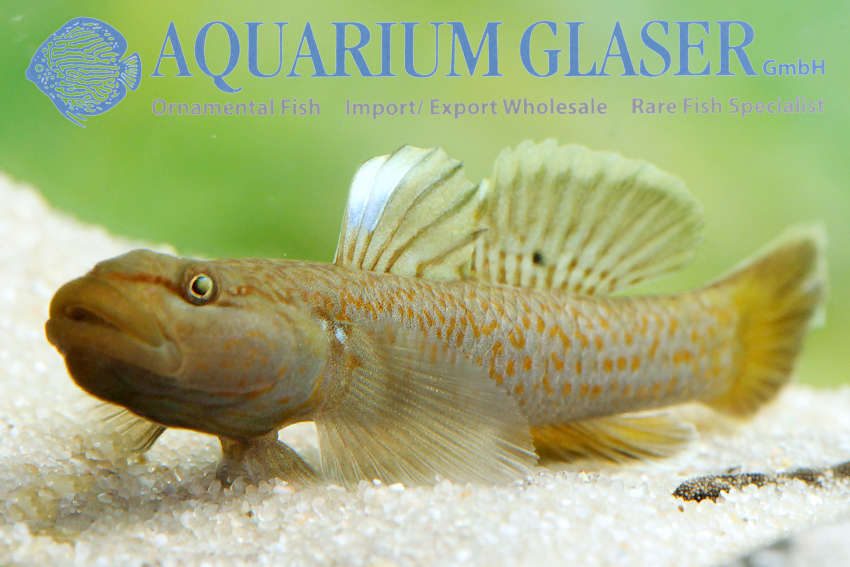
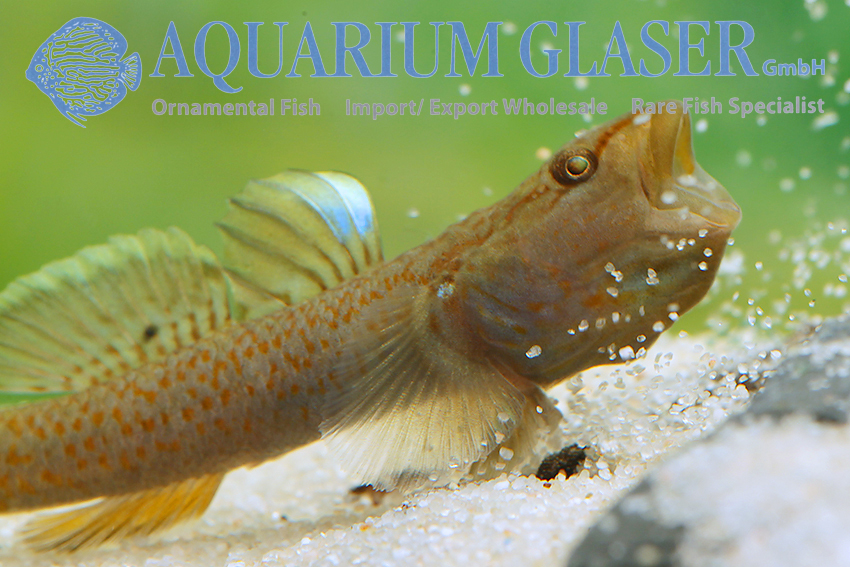
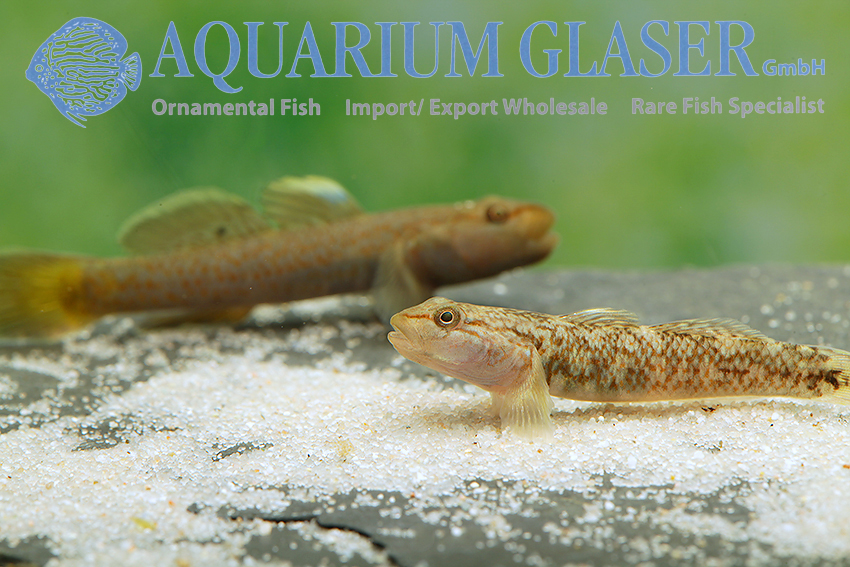
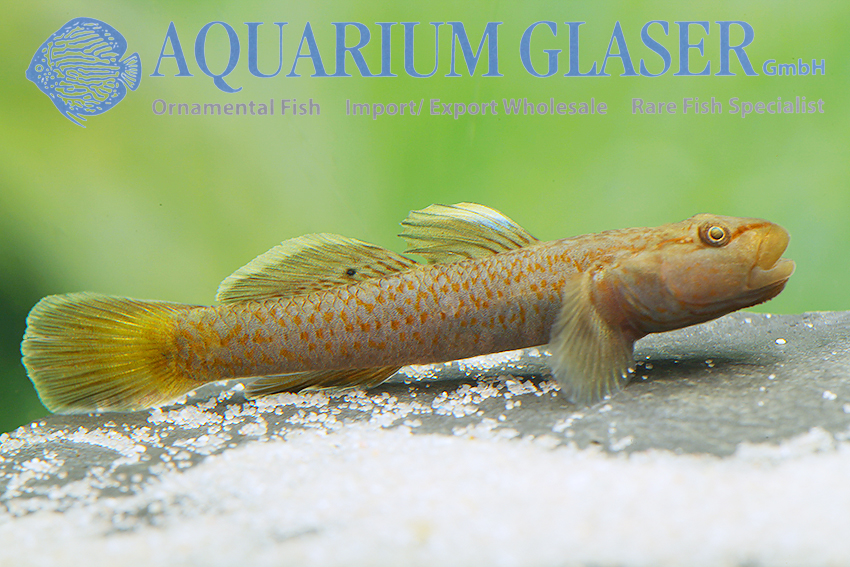
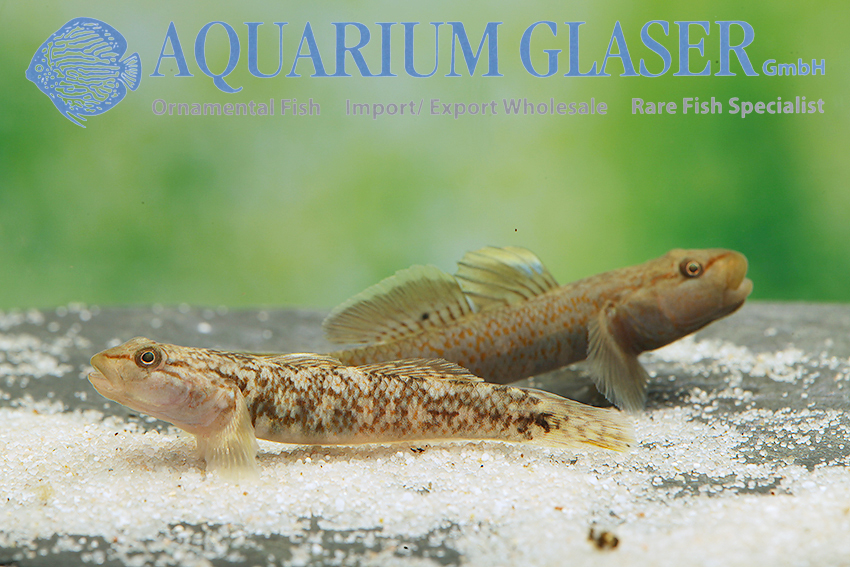
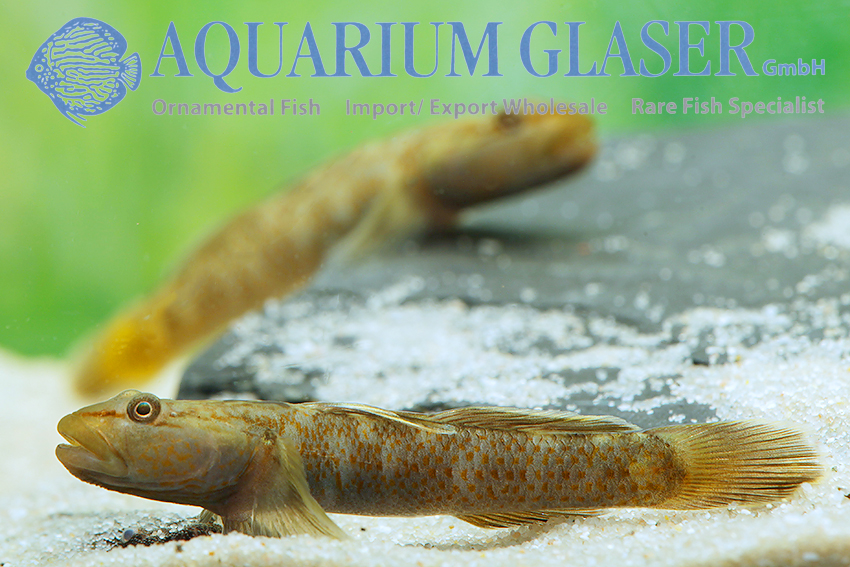
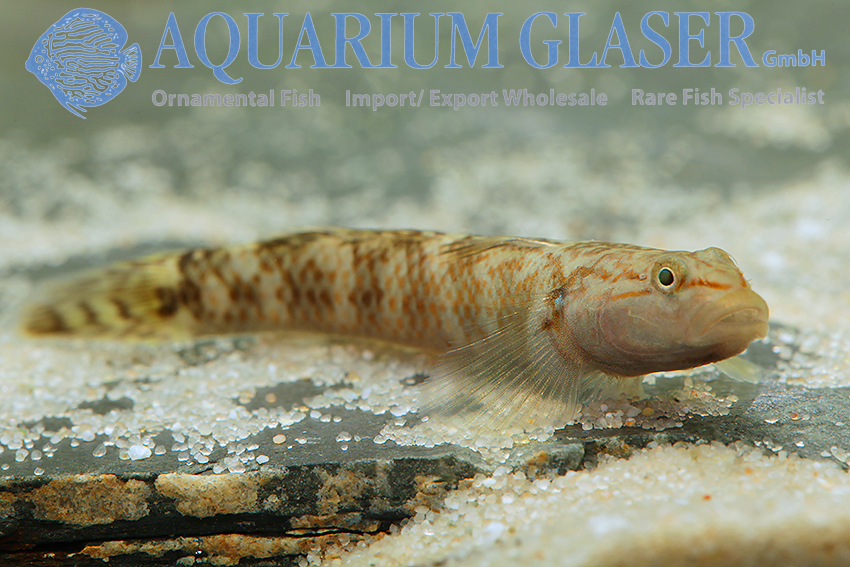
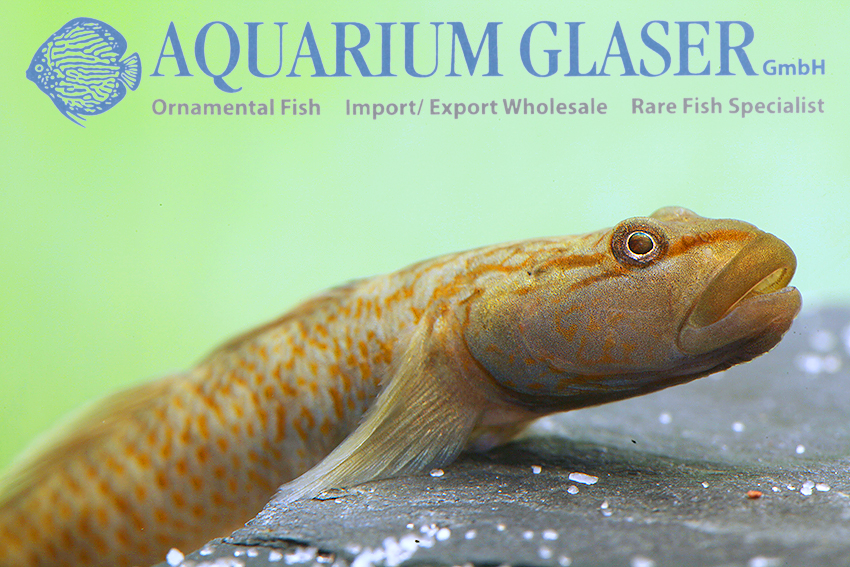
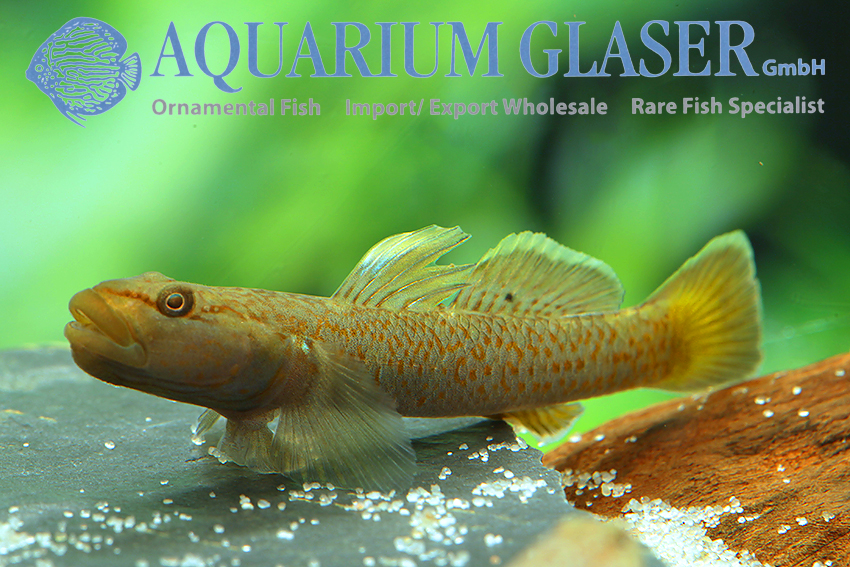
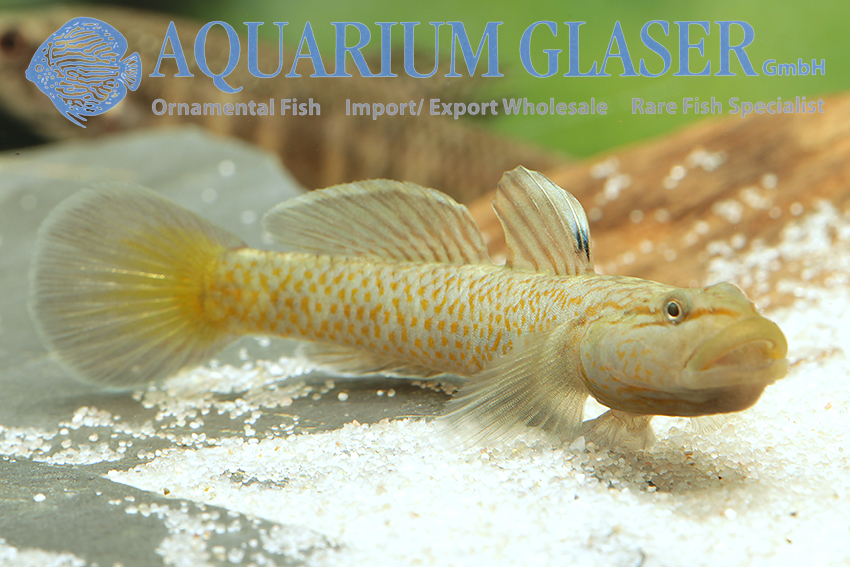
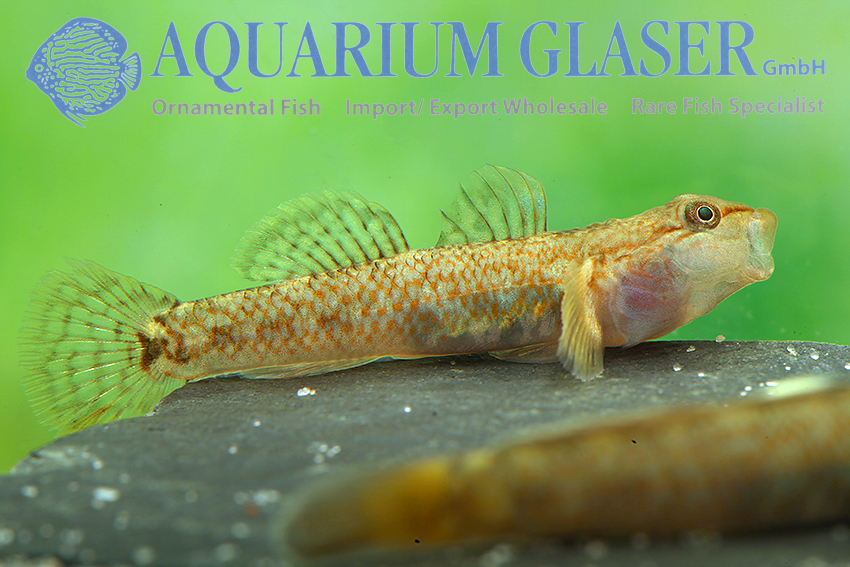
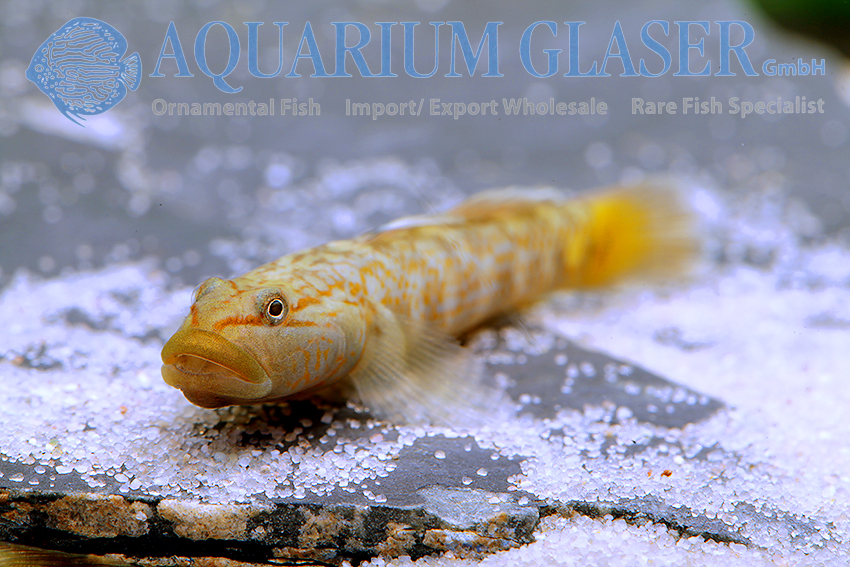
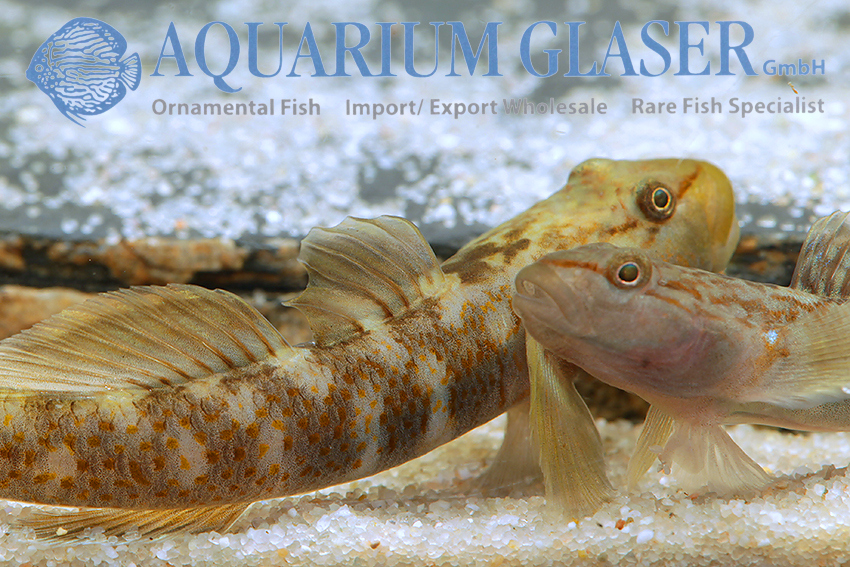
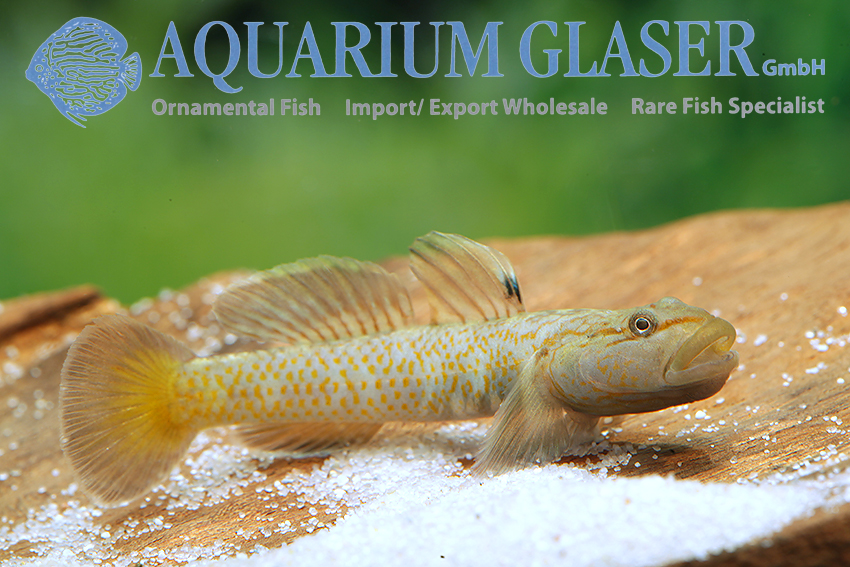
For the first time we could import Rhinogobius shennongensis from China. It originates from the Yangriwan, upper Hanjiang River, Mount Shennnong, Hubei Province. The maximum length is about 5-6 cm, males are larger than females. The sexes are most easily distinguished by the shape of the head. According to their origin, the fish are kept not too warm (18-24°C), in clear, oxygen-rich water with a good current. They are bottom fish, the males form territories. Rhinogobius shennongensis is somewhat quarrelsome; therefore possible tank mates should not be too squeamish. All common ornamental fish food is eaten, although some specimens do not like dry food. Frozen food is always accepted.
For our customers: the fish have code 453480 on our stocklist. Please note that we only supply wholesale.
Text & photos: Frank Schäfer
Violet Gobies arrived!

Sadly
we can offer the Violet Goby, Gobioides broussonnetii, only very
occasionally. Now we obtained once more a shipment from Colombia that
contained this odd bottom dweller. The maximum length reported in
literature for this fish is around 40 cm. These gobies are absolutely
peaceful plankton feeders. Fine sand should be offered for this fish on
the bottom of the tank.

For our customers: the fish have code 254683 on our stocklist. Please note that we exclusively supply the wholesale trade.

Text & photos: Frank Schäfer
Wonderful Neon gobies arrived

The Neon gobies of the genus Stiphodon are very difficult to determine, for the larvae develop in marine environment; so the species have a very wide distribution. The adult fish, however, live exclusively in freshwater.




The males can change their coloration in a glimpse; the mating coloration is species-specific. Different species look extremely similar in neutral colour, see for example the picture with Stiphodon cf. atratus and S. ornatus. Our specimens belong in all probability for the larger part to the species Stiphodon ornatus, among them are a few Stiphodon weberi as by-catch.



Neon gobies are very peaceful fish that feed on Aufwuchs. They prefer clear, clean and fast running water.

For our customers: the fish have code 456072 on our stocklist. Please note that we exclusively supply the wholesale trade.
Text & photos: Frank Schäfer





